Sponsored Content by Sphere BioReviewed by Alex SmithMar 3 2023
Uniform picoliter volume droplets (picodroplets) may be produced with the use of microfluidic devices with accurate flow control and well-defined microchannel geometries. These picodroplets can be utilized as miniaturized “test tubes” for high-throughput bioassays.
Biomolecules and cells captured in picodroplets are able to be incubated, identified, categorized, imaged and dispensed in a high-throughput manner utilizing patented microfluidic designs.
Cyto-Mine® delivers an entirely integrated microfluidic workflow of single-cell encapsulation, incubation, assay, categorizing, imaging, and dispensing, with the ability to process up to tens of millions of single cells in one working day.
Restricting individual cells into picodroplets allows the application of a variety of novel bioassays and applications in cell therapy research, biotherapeutic discovery and development, immuno-oncology and genome editing.
Cyto-Mine® overview
Workflow

Image Credit: Sphere Bio
Features
Integrated microfluidics:
- Utilizes microfluidic picodroplets
- Entirely integrated workflow
Single-cell secretion assay:
- Integrated single-cell secretion assay
- Validated for Hybridoma, CHO and B cells
High-throughput screening:
- Fluorescence-based categorization
- 10,000s to ~40 million cells per run per day
Monoclonality assurance:
- High-fidelity dispensing in 96- or 384-well MTPs
- Image evidence of monoclonality
Cell-friendly workflow:
- Greater cell viability
- Superior single-cell outgrowth rate
Designed for biopharma:
- Antibody discovery and cell line development
- Animal origin-free, single-use consumables
FRET assays
Using pairs of affinity probes, FRET assays can be utilized to directly identify the antibodies produced by a single cell. Antigen-specific assays can be applied with the use of a soluble antigen as one of the FRET assay probes.
Antigen-specific FRET assay for antibody discovery
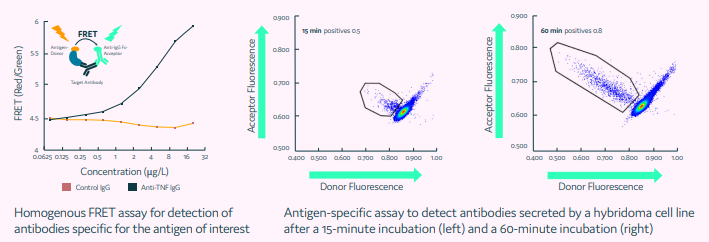
Image Credit: Sphere Bio
Cell binding assays
The Cyto-Mine® detection system is able to differentiate between co-localized fluorescence on the exterior of a single cell within a picodroplet and diffused fluorescence across a picodroplet. This can be utilized to precisely identify the binding of the antibodies to the membrane antigen of concern.
Mammalian display library screening
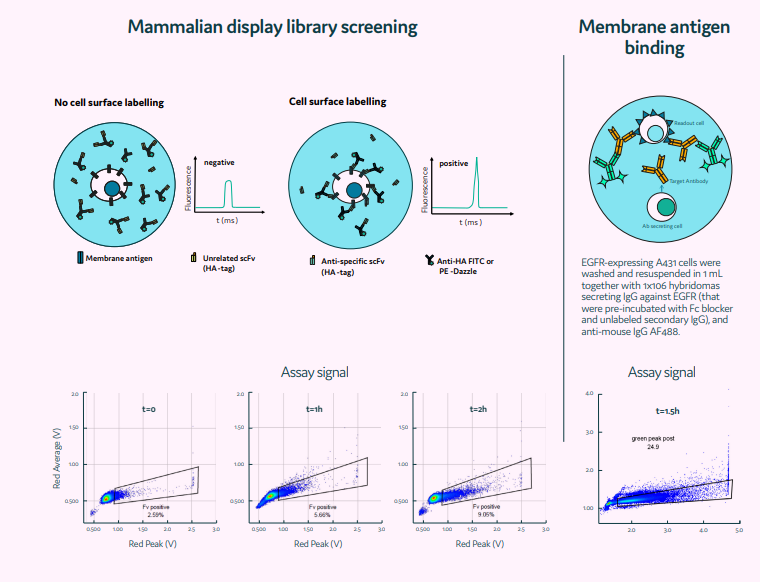
Image Credit: Sphere Bio
Functional assays
Picodroplets offer a cell-friendly assay setting. Numerous cell types are able to be cultured in picodroplets for up to several days, enabling the use of Cyto-Mine® for cell engineering and various functional assays.
Cell culture in picodroplets
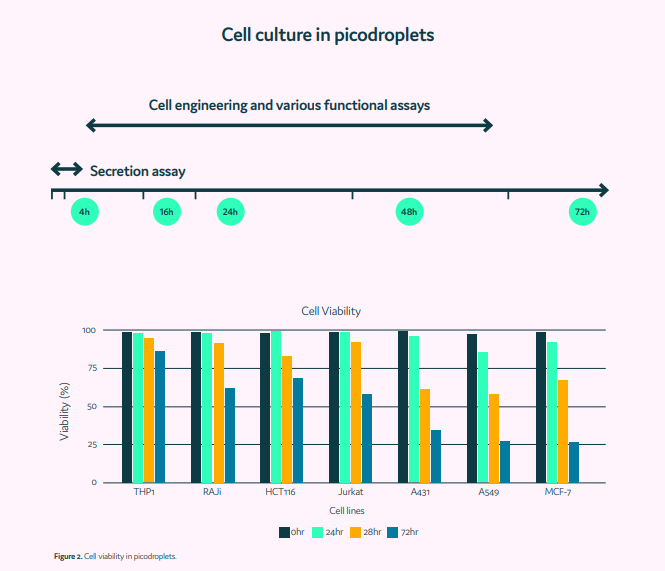
Image Credit: Sphere Bio
Cell engineering and cloning
Experimental Procedure:
- HTC116 FIRE-line (Horizon Discovery) was engineered to receive the genomic insertion of the mutated GFP gene.
- HCT116 cells (3.5x105 cells) were co-encapsulated in picodroplets, combined with Cas9 RNP and crRNA1/tracrRNA complex 100 pM, ssODN 200 pM, DharmaFect Duo 0.4 μL/150 μL sample.
- Pre-produced picodroplets were incubated at 37 °C for 48 hours to enable genome editing and GFP expression

Image Credit: Sphere Bio
CAR-T cell functional assay
Cytotoxic Lymphocytes secrete Granzyme B and Perforin when encountering a target cell instigating apoptotic cell death. A fluorogenic substrate (SensoLyte® Granzyme B Activity Assay Kit (Anaspec Inc.)) was utilized to detect the Granzyme B released by the CAR-T cells.
Assay principle
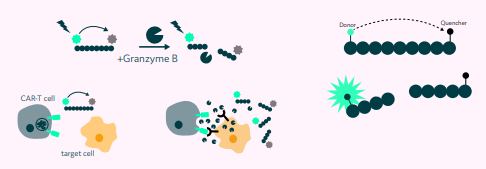
Image Credit: Sphere Bio
Workflow
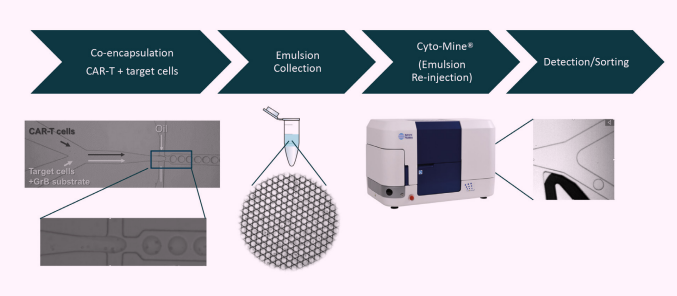
Image Credit: Sphere Bio

 Download the full poster
Download the full poster
Acknowledgments
Produced from materials originally authored by Frank F. Craig, Elena Shvets, Frank Gesellchen, Xin Liu from Sphere Bio.
References and further reading
- D. Josephides, et al., (2020) Cyto-Mine: An Integrated, Picodroplet System for High-Throughput Single-Cell Analysis, Sorting, Dispensing, and Monoclonality Assurance, SLAS,
- R. Gaa, et al. (2022) Versatile and rapid microfluidics-assisted antibody discovery, mAbs.
- L. P. Pybus, et al. (2022) Coupling picodroplet microfluidics with plate imaging for the rapid creation of biomanufacturing suitable cell lines with high probability and improved multi-step assurance of monoclonality, Biotech Method.
About Sphere Bio
Our vision
Our philosophy is simple. We combine our knowledge and resources to help you find rare and valuable biological variants, while helping you to save time, reduce costs and stay a step ahead of the competition.
Our novel single cell analysis systems offer the rapid screening and characterisation of single cells. These systems are underpinned by our patented picodroplet technology, specifically designed to increase your chances of finding that rare ‘one-in-a-billion’ molecule or cell that could be an industry blockbuster.
We understand that time is of the essence. That’s why our technologies boost throughput and assay sensitivity across a range of applications. Most importantly, our flexible systems evolve alongside your changing research needs, providing an adaptable platform that helps you to meet your goals.
Our history
Founded in 2010, Sphere Bio is an established Life Sciences company, originally spun out from the University of Cambridge. We initially developed 25 patented products – biochips and specialist chemicals – which currently assist hundreds of customers globally with their research.
We initially focused on producing novel biochip systems and providing R&D services. We have since extended our expertise and are developing a technology platform that enables discovery in a range of growing markets through single cell analysis. Our systems make the development of new biopharmaceuticals faster and more cost-effective, improve monoclonal antibody screening, cell line development, and overall research efficiency in a number of other applications including synthetic biology, single cell diagnostics, prognostics and single cell genome editing.
The Cyto-Mine® Single Cell Analysis System is our flagship product – the first integrated, benchtop system to automatically analyse, sort and dispense millions of individual cells in just a single day.
Our partnerships
We value and are always open to discussing new collaborative, successful and innovative academic and industry partnerships to further develop and improve our single cell technologies.
Our Technology Access Programmes and Collaborative Services exist to enable academic researchers and companies alike to tap into our application-specific expertise through direct partnerships.
Sphere Bio. We work small so you can think big.
Sponsored Content Policy: News-Medical.net publishes articles and related content that may be derived from sources where we have existing commercial relationships, provided such content adds value to the core editorial ethos of News-Medical.Net which is to educate and inform site visitors interested in medical research, science, medical devices and treatments.